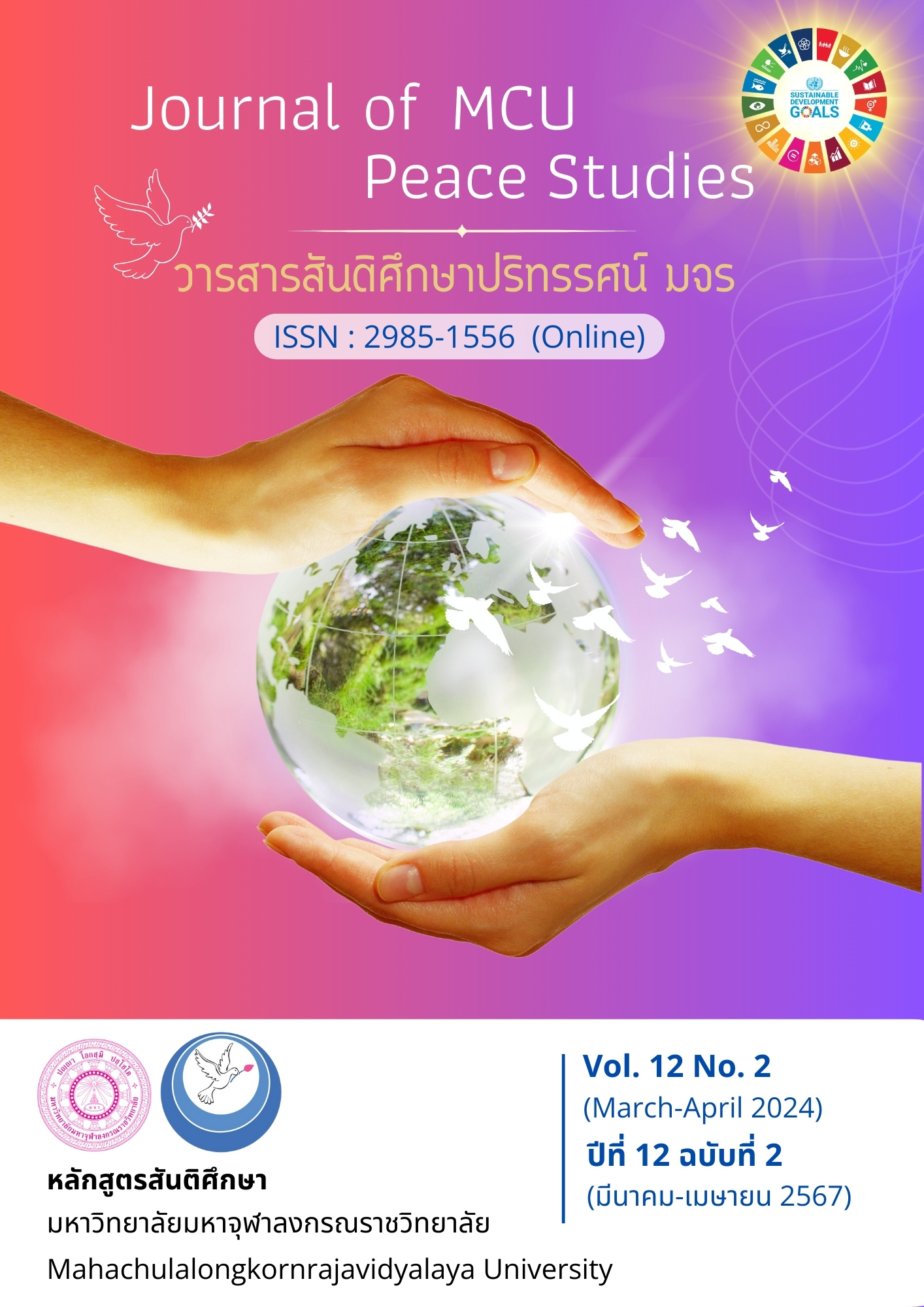The Development of Wat Mai (Yai Paen) Public Sector Mediation Center, Bangkok Noi District, Bangkok, Based on Buddhist Peaceful Means
Main Article Content
Abstract
The study entitled “The Development of Wat Mai (Yai Paen) Public Sector Mediation Center, Bangkok Noi District, Bangkok, based on Buddhist Peaceful Means” employed both qualitative research and action research methods with the following objectives: 1) to investigate the context, problems, needs, as well as concepts on dispute mediation, in relation to the development of Wat Mai (Yai Paen) public sector mediation center, Bangkok Noi District, Bangkok; 2) to explore the Buddhist peaceful means favorable to the development of Wat Mai (Yai Paen) public sector mediation center, Bangkok Noi District, Bangkok; and 3) to propose the development of Wat Mai (Yai Paen) public sector mediation center, Bangkok Noi District, Bangkok.
From the study, the following results are found: 1) The research context indicated that there is an elevated probability of conflict, but the problem-solving strategies remain the same, relying on dispute mediation by community leaders. However, the outcome of the agreement is not legally enforceable as legally recognized dispute mediation must be mediated by a state-licensed organization as an operator. Wat Mai (Yai Paen) community requires a conflict mediation agency inside the community; therefore, a public sector mediation sector based on the Dispute Mediation Act B.E. 2562 is required to ensure that dispute mediation will be legally certified. With the establishment of Wat Mai (Yai Paen) Public Sector Mediation Center, the concept on organizational development has been integrated to develop personnel for dispute mediation in the community; 2) Sāraṇīyadhamma (six states of conciliation) has been applied for coexisting in the society, which is aligned with the concepts on public engagement where laws and regulations are required. Sāraṇīyadhamma can be used as a guideline to manage the center and develop the dispute mediation properly; and 3) The development process is divided into 5 stages which are: (1) Gathering, (2) Enhancing, (3) Adjusting the process, (4) Developing the task, and (5) Sustaining. This results the temple in the following characteristics: an integrated temple, a determined temple, a mediated temple, a truthful temple, an awakened temple, and a wisdom temple.
Article Details

This work is licensed under a Creative Commons Attribution-NonCommercial-NoDerivatives 4.0 International License.
Views and opinions expressed in the articles published by The Journal of MCU Peace Studies, are of responsibility by such authors but not the editors and do not necessarily reflect those of the editors.
References
Buranasing, T., Phramaha Hansa Dhammahaso, & Phra Pramote Vadakovito. (2020). A Judicial Public Mediation Model for People by Buddhist Peaceful Means: Case Study of Sawai Sub-district, Prang Ku District, Sri Sa Ket Province. Journal of MCU Peace Studies, 8 (Sup), S147-S160.
Chueathai, S. (1967). General Legal Knowledge. (2nd ed.). Bangkok: Winyuchon Publication House.
Duangkiao, T. (2023). The Development of Wat Mai (Yai Paen) Public Sector Mediation Center, Bangkok Noi District, Bangkok, Based on Buddhist Peaceful Means. (Doctoral Dissertation). Graduate School: Mahachulalongkornrajavidyalaya University. Ayutthaya.
Khantahirun, U. (2022). A Model of the Management of Public-sector Dispute Mediation Center by Buddhist Peaceful Means: A Case Study of Public-sector Mediation Center, Sawai Subdistrict, Prangku District, Sisaket Province. (Doctoral Dissertation). Graduate School: Mahachulalongkornrajavidyalaya University. Ayutthaya.
Khantahirun, U., Phrakhrupalhad Paññavorawat, & Phrakhrupalhad Adisak Vajirapañño. (2022). A Model of the Management of Public-sector Dispute Mediation Center by Buddhist Peaceful Means: A Case Study of Public-sector Dispute Mediation Center, Sawai Subdistrict, Prangku District, Sisaket Province. Journal of MCU Peace Studies, 10(6), 2549-2665.
Phra Brahmagunabhorn (P.A. Payutto). (2003). Dictionary of Buddhism. Retrieved January 31, 2023, from https://84000.org/tipitaka/dic/d_item.php?i=287
Phra Phakawit Paññajāto, & Phra Pramote Vadakovido. (2022). The Value and Importance of Villages, Temples, and Schools towards the Development of Public Sector Dispute Mediation Center: A Case Study of the Public Sector Dispute Mediation Center in Sawai Subdistrict, Prangku District, Sisaket Province. Journal of MCU Peace Studies, 10(2), 652-664.
Prachaya, V. (2012). The Trend of Globalization and the Problems of Thai Society, Teaching Documents for the Subject Thai and World Society. (15th ed.). Nonthaburi: Sukhothai Thammathirat Open University.
Pratheuangrattana, C. (2019). The Public Sector Dispute Mediation according to the Mediation Act according to the Mediation Act in 2562 B.E. (A.D. 2019): Opportunities in B.E. 2562 (A.D. 2019): Opportunities and Challenges and Challenges. Journal of Thai Justice System, 3, 9-12.
Rosthip, C. (2023). The Development of Wat Mai (Yai Paen) Public Sector Mediation Center, Bangkok Noi District, Bangkok, Based on Buddhist Peaceful Means. (Doctoral Dissertation). Graduate School: Mahachulalongkornrajavidyalaya University. Ayutthaya.
Sanguthai, Y. (1975). Principles of Jurisprudence. Bangkok: Thammasat Printing House.
Thailand Institute of Justice. (2015). Diversion of Cases and Offenders. Bangkok: Academic Seminar.
Thapvongse, C. (2019). Mediator Handbook. (3rd ed.). Bangkok: Saeng Chan Press Limited Partnership.

